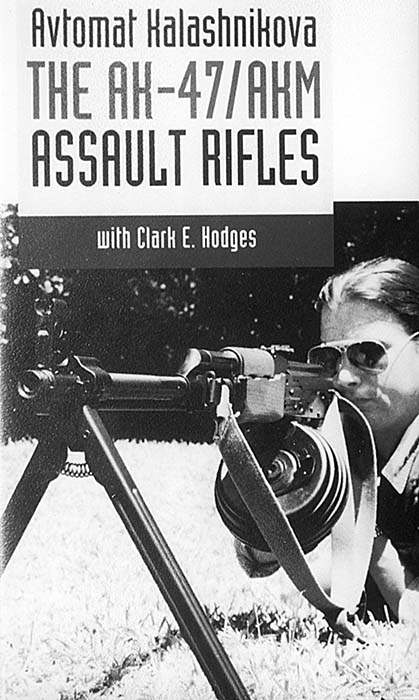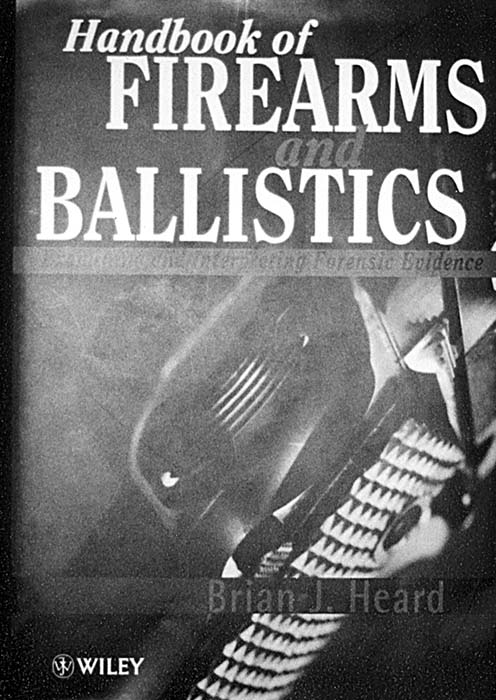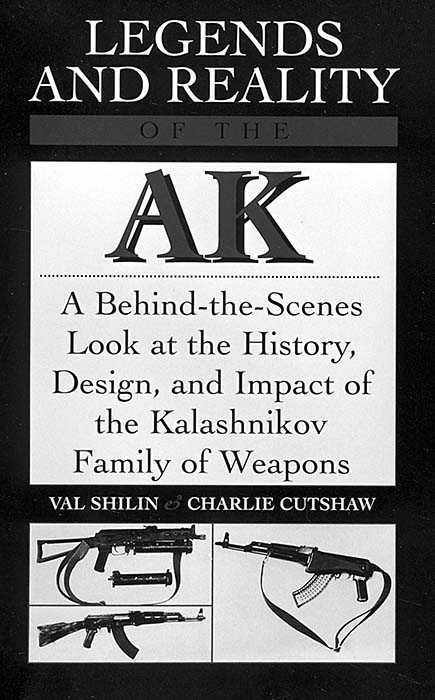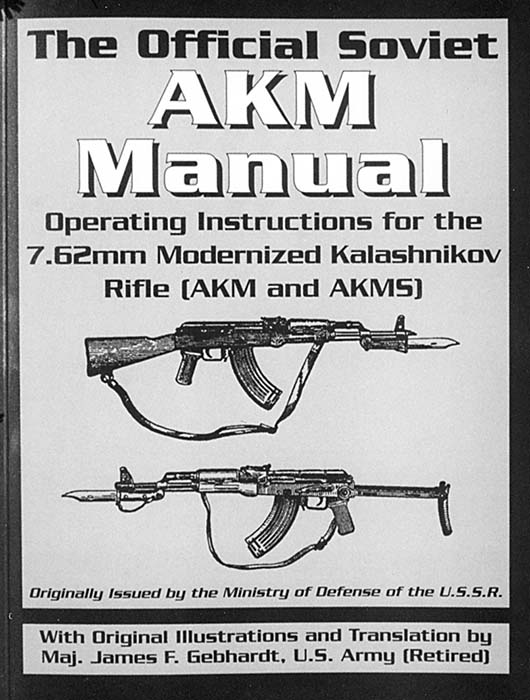By David M. Fortier
AVTOMAT KALASHNIKOVA THE AK-47/AKM ASSAULT RIFLES
with Clark E. Hodges
Paladin Press
Dept. SAR
P.O. Box 1307
Boulder, CO 80306
1-800-392-2400
ISBN 0-87364-951-6
$29.95 plus S&H
65 minutes VHS
Reviewed by David M. Fortier

It has been said that the Americans export Coca-Cola, the Japanese export Sonys, and the Soviets export Kalashnikovs. Mikhail Kalashnikov’s rifle has been a tool of revolution as well as tyranny. Produced in astounding numbers and copied by countries on both sides of the Iron Curtain the AK series of rifles stand as one of the most influential and successful designs of all time. Paladin Press now offers an excellent video on this rifle series. Beginning with actual film footage of combat on the Eastern Front the video looks at various German automatic weapons that influenced Kalashnikov. The MP-38/40, FG-42, MKB-42, and STG-44 are all covered along with the 7.92×33 Kurz cartridge. The Soviet PPSh-41 and PPS-43 sub-machineguns are covered along with the development of the Soviet 7.62×39 M43 cartridge. Kalashnikov’s first design, the PPK-42 sub-machinegun prototype is discussed along with the Samozaryadnyi Karabin Simonova 45’s adoption. From the AK-46 trial rifle to the AKS-74U, Kalashnikov’s design is shown and discussed in detail. The three receiver variations of the AK-47 are discussed and identified. The AKM, RPK, East German, Romanian, Hungarian, Finnish, Israeli, Yugoslavian M-76 sniper rifle, Polish, and Red Chinese versions are all discussed and identified. Selector switch markings are covered for identification purposes. The 5.45×39.5 cartridge development is discussed. The method of operation is shown with a cut-away model and an excellent firing demonstration is given. This is a first rate piece of work. The camera work is very good, and the World War II footage is excellent. Mr. Hodges does a very good job and explains the subject in a simple and easy to understand manner. Unlike many other videos on the market, this one is BOTH very informative and fun to watch. I recommend it.
Handbook of Firearms and Ballistics Examining and Interpreting Forensic Evidence
By Brian J. Heard
Published by John Wiley & Sons Ltd Baffins Lane Chichester,
West Sussex
PO19 IUD,
England
ISBN #0-471-96563-4
Price $65.00 plus s&h
Reviewed by Christopher Trumble

Just about every day we read in the newspaper or see on the television news reports of shootings. Whether these incidents are gang related drive by shootings or mass shootings by a lone maniac, there is a Forensic Firearms Examiner that analyzes each fired ammunition component to assist the courts in deciding a convicted person’s fate. Brian Heard has authored a book on the Forensic Firearms Examiner’s duties.
This book is a unique reference manual on the Forensic Firearms field. It briefly covers all areas of a Forensic Firearms Examiner’s training program. Chapters include firearms history and operation, ammunition nomenclature and function, internal, external and terminal ballistics, bullet identification, bullet penetration, distance determination, serial number restoration and expert witness testimony. After reading this book you soon realize that the Forensic Firearms Examiner doesn’t just match the bullet to the gun like all the big screen movies depict.
For police investigators, judges, lawyers, forensic scientists and anyone interested in real crime laboratory functions, this book is essential reading.
The numerous black and white photographs, graphs and charts are clear, easily understood and compliment the text. The information that is provided in this book is clearly explained and presented in an entertaining manner. The glossary, located in the back of the book, is a quick and useful reference to the vast number of terms specific to Forensic Firearms studies.
The author, Brian J. Heard, is well known and respected throughout the professional forensic community. His earlier experience was acquired with the Metropolitan Police Forensics Firearms Laboratory and New Scotland Yard, London United Kingdom, where he rose to the position of Deputy Head. Brian then became Officer in Charge of the Ballistics and Firearms Identification Bureau for the Royal Hong Kong Police where he continues to work today.
I have read this book on more than one occasion and continue to refer to its contents on a regular basis. I definitely recommend this book to serious students of firearms and those readers of pulp fiction crime novels that want to separate fact from fantasy. This book was written by a been there, done that, guy.
LEGENDS AND REALITY OF THE AK:
A Behind the Scenes Look at the History, Design, and Impact of the Kalashnikov
Family of Weapons
By Val Shilin & Charlie Cutshaw
Paladin Press
Dept. SAR
P.O. Box 1307
Boulder, CO 80306
1-800-392-2400
$35 plus S&H
ISBN 1-58160-069-0
188 pages, well illustrated
Reviewed by David M. Fortier

Every weapon’s collector has a certain niche of firearms that is their favorite. It may be Pre-64 Winchesters, GE Miniguns, or literally anything in between. For me it’s Soviet/Russian small arms. I just enjoy shooting SVD Dragunov’s at extreme range, or running a drum through an RPK. However, while I love shooting them, what fascinates me most about Soviet/Russian small arms is how little is actually known about them in the West. There is a whole world of Russian handguns, shotguns, submachineguns, assault rifles, sniper rifles, and machineguns (not to mention ammunition) that almost nothing is known of here. Luckily with the end of the Cold War this is slowly changing. In this work Mr. Shilin and Mr. Cutshaw take the reader to Izhevsk, Russia, home of the Izhmash Arms Factory and where Mikhail Kalashnikov worked. There the reader is taken from the development of the original AK-47 assault rifle through the many designs that followed to a look at the new cutting edge AN-94 assault rifle slated to replace the AK-74M currently in Russian service. Assault rifles, submachineguns, squad automatics, combat shotguns, sniper rifles, and handguns are touched on including many experimental models and designs previously unknown in the West. Well illustrated with black and white photos and in-depth explanations of new operating principles, this book does much to shed new light in previously dark corners. With the end of the Kalashnikov assault rifle drawing to a close with the Russian Army we stand at an interesting place in time. While the Kalashnikov will soldier on for the present time the writing is on the wall, the AN-94 Nikonov having been adopted to replace it back in 1994. This work gives the reader not only an in-depth look at the past and present of Russian small arms, but a glimpse into the future. I highly recommend it.
THE OFFICIAL SOVIET AKM MANUAL
Translation by Major James F. Gebhardt,
U.S. Army (Ret.)
Paladin Press
Dept. SAR
P.O. Box 1307
Boulder, CO 80306
1-800-392-2400
ISBN 1-58160-010-0
$16.00 plus S&H
120 pages
Reviewed by David M. Fortier

From the Six O’clock news covering a story in a distant land to the anti-gunners in the local media the AKM rifle is a common sight. Extremely popular in the United States in its semi-auto version, the Kalashnikov rifle is one of the most prolific weapons ever manufactured. Before its collapse the Soviet Union handed them out to whom ever asked for one. Copied in its original form by many countries and in modified form by others the chance of encountering a Kalashnikov series rifle is extremely high. Now Paladin Press brings the original Soviet military AKM manual to the American shooter. Translated from the original Russian by Major James F. Gebhardt it contains the original Soviet drawings and illustrations. Operation and functional characteristics of the weapon are explained. Complete disassembly and reassembly is shown step by step. Description and function of all parts as well as the correct method of sighting the rifle in is covered in detail. Deploying the weapon from various shooting positions is taught, including while on skis, from an armored transporter, from a truck, from cover, and against aerial targets. Use of the sling as a support is touched on, something it has been said that the Soviets never taught. Target selection and estimating range is covered as well as wind and extreme temperature and their effects. The 7.62×39 mm M43 cartridge is covered. The book contains a number of ballistic charts as well as an interesting chart on the penetration capabilities of the standard ball round and their armor-piercing incendiary round. Capabilities against such obstacles as helmets, flack jackets, brickwork, wooden beams, earthen obstacles, and more are given. Well done with good illustrations this manual contains much useful information. Whether you are the owner of a semi-auto version of the AKM or a U.S. service person who might face an AK in combat someday, this manual will be of interest.
| This article first appeared in Small Arms Review V3N12 (September 2000) |











